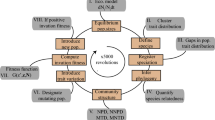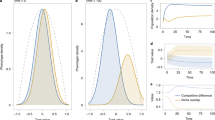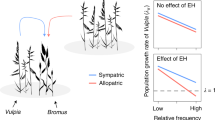Abstract
A cornerstone of biology is that coexisting species evolve to occupy separate ecological niches. Classical theory predicts that interspecific competition should lead to all potential niches being occupied, yet observational data suggest that many niches are unfilled. Here we show that theory can be reconciled with observational data by reconceptualizing competition in the Hutchinsonian niche space to distinguish between substitutable and non-substitutable resources. When resources are substitutable (for example, seeds of different size), the components of competition along the niche axes combine multiplicatively, leading to a densely packed niche space. However, when resources are non-substitutable (such as seeds and nest sites), we show that the components of competition combine additively. Disruptive selection therefore limits niche overlap between non-substitutable niche axes, leaving most potential niches unfilled. A key corollary is that increasing the number of niche axes may greatly increase the number of potential niches but does not necessarily increase diversity. We discuss observational data that are consistent with our model and consider implications for systems with invasive species. Our work reinforces the power of competition to drive major ecological patterns: while niche space informs on species that might exist, only a small and potentially arbitrary subset will coexist in sympatry.
This is a preview of subscription content, access via your institution
Access options
Access Nature and 54 other Nature Portfolio journals
Get Nature+, our best-value online-access subscription
$29.99 / 30 days
cancel any time
Subscribe to this journal
Receive 12 digital issues and online access to articles
$119.00 per year
only $9.92 per issue
Buy this article
- Purchase on Springer Link
- Instant access to full article PDF
Prices may be subject to local taxes which are calculated during checkout




Similar content being viewed by others
References
Hutchinson, G. E. Concluding remarks. Cold Spring Harb. Symp. Quant. Biol. 22, 415–427 (1957).
Yoshiyama, R. M. & Roughgarden, J. Species packing in two dimensions. Am. Nat. 111, 107–121 (1977).
Pacala, S. W. & Roughgarden, J. The evolution of resource partitioning in a multidimensional resource space. Theor. Popul. Biol. 22, 127–145 (1982).
Polechová, J. & Storch, D. Ecological niche. Encycl. Ecol. 2, 1088–1097 (2008).
Begon, M., Townsend, C. R. & Harper, J. L. Ecology: from Individuals to Ecosystems (Wiley-Blackwell, Malden, 2005).
Leimar, O., Sasaki, A., Doebeli, M. & Dieckmann, U. Limiting similarity, species packing, and the shape of competition kernels. J. Theor. Biol. 339, 3–13 (2013).
May, R. M. On the theory of niche overlap. Theor. Popul. Biol. 5, 297–332 (1974).
Macarthur, R. & Levins, R. The limiting similarity, convergence, and divergence of coexisting species. Am. Nat. 101, 377–385 (1967).
Meszéna, G., Gyllenberg, M., Pásztor, L. & Metz, J. A. J. Competitive exclusion and limiting similarity: a unified theory. Theor. Popul. Biol. 69, 68–87 (2006).
Schoener, T. W. Resource partitioning in ecological communities. Science 185, 27–39 (1974).
Bolnick, D. I. Intraspecific competition favours niche width expansion in Drosophila melanogaster. Nature 410, 463–466 (2001).
Scheffer, M. & van Nes, E. H. Self-organized similarity, the evolutionary emergence of groups of similar species. Proc. Natl Acad. Sci. USA 103, 6230–6235 (2006).
Rohde, K. Nonequilibrium Ecology (Cambridge Univ. Press, New York, 2005).
Walker, T. D. & Valentine, J. W. Equilibrium models of evolutionary species diversity and the number of empty niches. Am. Nat. 124, 887–899 (1984).
Rabosky, D. L. Ecological limits and diversification rate: alternative paradigms to explain the variation in species richness among clades and regions. Ecol. Lett. 12, 735–743 (2009).
Terradas, J., Peñuelas, J. & Lloret, F. The fluctuation niche in plants. Int. J. Ecol. 2009, 1–5 (2009).
Pacala, S. & Roughgarden, J. Resource partitioning and interspecific competition in two two-species insular anolis lizard communities. Science 217, 444–446 (1982).
Tilman, D. Resource Competition and Community Structure (Princeton Univ. Press, Princeton, 1982).
Gupta, S. et al. The maintenance of strain structure in populations of recombining infectious agents. Nat. Med. 2, 437–442 (1996).
Buckee, C. O., Recker, M., Watkins, E. R. & Gupta, S. Role of stochastic processes in maintaining discrete strain structure in antigenically diverse pathogen populations. Proc. R. Soc. B 108, 15504–15509 (2011).
Penman, B. S., Ashby, B., Buckee, C. O. & Gupta, S. Pathogen selection drives nonoverlapping associations between HLA loci. Proc. Natl Acad. Sci. USA 110, 19645–19650 (2013).
Watkins, E. R. et al. Vaccination drives changes in metabolic and virulence profiles of Streptococcus pneumoniae. PLoS Pathog. 11, e1005034 (2015).
Croucher, N. J. et al. Population genomics of post-vaccine changes in pneumococcal epidemiology. Nat. Genet. 45, 656–663 (2013).
Lourenço, J. et al. Lineage structure of Streptococcus pneumoniae may be driven by immune selection on the groEL heat-shock protein. Preprint at http://bioRxiv.org/content/early/2017/07/05/082990 (2016).
Ricklefs, R. E. Species richness and morphological diversity of passerine birds. Proc. Natl Acad. Sci. USA 109, 14482–14487 (2012).
Noue, M. N. I., Okoyama, J. Y., Inoue, M. N. & Yokoyama, J. Competition for flower resources and nest sites between Bombus terrestris (L.) and Japanese native bumblebees. Appl. Entomol. Zool. 45, 29–35 (2010).
McQuillan, P. B. & Hingston, A. B. Displacement of Tasmanian native megachilid bees by the recently introduced bumblebee Bombus terrestris (Linnaeus, 1758) (Hymenoptera: Apidae). Aust. J. Zool. 47, 59–65 (1999).
Ishii, H. S. Community-dependent foraging habits of flower visitors: cascading indirect interactions among five bumble bee species. Ecol. Res. 28, 603–613 (2013).
Soberón, J. & Nakamura, M. Niches and distributional areas: concepts, methods, and assumptions. Proc. Natl Acad. Sci. USA 106, 19644–19650 (2009).
Crisp, M. D. et al. Phylogenetic biome conservatism on a global scale. Nature 458, 754–756 (2009).
Brown, W. L. & Wilson, E. O. Character displacement. Syst. Zool. 5, 49–64 (1956).
Urban, M. C. et al. The evolutionary ecology of metacommunities. Trends Ecol. Evol. 23, 311–317 (2008).
Geritz, S. A. H., Kisdi, E., Meszena, G. & Metz, J. A. J. Evolutionarily singular strategies and the adaptive growth and branching of the evolutionary tree. Evol. Ecol. 12, 35–37 (1998).
Acknowledgements
We thank G. Barabás, T. Gross, R. Iritani, S. Nee and R. Noble for helpful comments on the manuscript. B.A. acknowledges funding from the Natural Environment Research Council (NE/N014979/1). S.G., E.W. and J.L. received funding from the European Research Council under the European Union’s Seventh Framework Programme (FP7/2007-2013)/ERC grant agreement no. 268904-DIVERSITY. K.R.F. is funded by European Research Council grant 242670 and a Calleva Research Centre for Evolution and Human Science (Magdalen College, Oxford) grant.
Author information
Authors and Affiliations
Contributions
K.R.F. and S.G. conceived the study. E.W. and J.L. analysed empirical data sets. B.A., E.W. and S.G. performed modelling work. B.A., E.W., K.R.F. and S.G. contributed equally to writing the manuscript.
Corresponding authors
Ethics declarations
Competing interests
The authors declare no competing financial interests.
Additional information
Publisher’s note: Springer Nature remains neutral with regard to jurisdictional claims in published maps and institutional affiliations.
Electronic supplementary material
Supplementary Information
Supplementary Figure 1
Supplementary Code
Source code for the model described in Ashby et al. ‘Competing species leave many potential niches unfilled’
Rights and permissions
About this article
Cite this article
Ashby, B., Watkins, E., Lourenço, J. et al. Competing species leave many potential niches unfilled. Nat Ecol Evol 1, 1495–1501 (2017). https://doi.org/10.1038/s41559-017-0295-3
Received:
Accepted:
Published:
Issue Date:
DOI: https://doi.org/10.1038/s41559-017-0295-3
This article is cited by
-
General statistical model shows that macroevolutionary patterns and processes are consistent with Darwinian gradualism
Nature Communications (2022)
-
Genomic analysis of field pennycress (Thlaspi arvense) provides insights into mechanisms of adaptation to high elevation
BMC Biology (2021)
-
Complex yeast–bacteria interactions affect the yield of industrial ethanol fermentation
Nature Communications (2021)
-
Obligate cross-feeding expands the metabolic niche of bacteria
Nature Ecology & Evolution (2021)
-
Multidimensional niche differentiation might buffer invasion impacts: the case of oligohaline corophiids (Crustacea: Amphipoda) in the Baltic Sea
Biological Invasions (2021)



